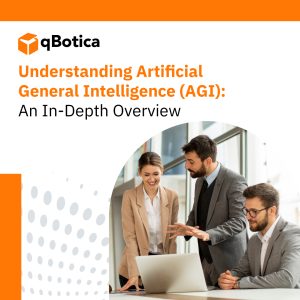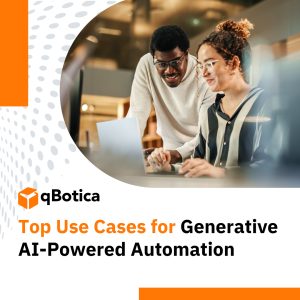Businesses worldwide have experienced significant ROI and savings thanks to automating redundant tasks through robotic process automation (RPA). Industry experts predict that RPA could shed another $2 trillion in workforce costs in the coming years. In an increasingly digital economy, experts predict that using RPA and artificial intelligence (AI) on a larger scale will add as much as $15.7 trillion to the global economy by 2030.
As exciting and game changing as robotic process automation is, the word “robot” instantly conjures foreboding images of a dystopian future. But automation doesn’t mean people go away. Yes, automated processes can work faster and more efficiently than people, but they rely on humans to guide them. When bots and people seamlessly align, businesses can experience exponential growth.
Machine vs. human: A tale of two types of intelligence
RPA refers to computer software that mimics repeatable business tasks usually handled by humans. It can incorporate AI and machine learning to continually expand its skillset and make better decisions based on new information it receives. This imitating ability gives automation two huge advantages over humans:
- Robotic Process Automation can automatically identify informational patterns, allowing it to see and optimize trends or recognize mistakes that humans might overlook. For instance, a software bot can scan customer purchases over several years and immediately report on areas with the best future sales opportunities.
- Software bots never get physically tired and can keep working 24/7, automatically boosting productivity. On top of that, they can work faster and with almost 100% accuracy, eliminating human errors and saving time and money.
These qualities make RPA and AI software ideal for handling lower-level, repetitive tasks in a closed management system, such as an assembly-line environment where speed and accuracy are essential. For example, Amazon recently implemented algorithms in its warehouses that allow automated bots to supervisors human workers, with the ability to adjust schedules to improve productivity and even fire employees who consistently miss quotas.
Robots’ infinite data-crunching abilities are valuable for various practices, but they can’t replace humans. For example, only humans can anticipate unexpected changing situations. Human intelligence is still the best tool for handling open management systems where teams must deal with unpredictable outside influences and respond to external input, such as business meetings with clients and strategy planning sessions. So, enduring business success still requires human assistance to think critically, create visions for the future, and continually adapt bots to handle complex challenges.
Why do robots need human assistance?
Coding updates
Robots need humans to write codes that instruct them to handle various situations and outcomes. Once programmed, machine-learning software is excellent at finding patterns from the information it already understands, but it still lacks the agility of human intelligence to react to new situations.
It’s almost impossible to develop resilient bots that can automatically course-correct the first time something comes up, even for the best data-science programmers.
However, once an Robotic Process Automation bot recognizes an issue it has come across before, its computing power can communicate faster and more accurately than a human could, such as through automated phone systems that can quickly locate banking balances or verify travel itineraries.
Structured vs. unstructured data
RPA software also relies on humans for structured data, or pre-defined and easily searchable information, to begin executing workflows. That may require humans to turn unstructured data—such as audio, video, PowerPoint presentations, email, and social media postings—into structured data that robots can process to optimize back-end office automation.
Unattended vs. attended: Two RPA options
When dealing with RPA processes, businesses have two categories to work with:
- Unattended RPA is fully automated with no human interaction. This option works well for situations that deal almost entirely with structured information, which is already in a form that RPA bots can easily search and understand. Examples could be calculations for financial reports and spreadsheets or scanning documents and sending them to the correct department.
- Attended RPA is where humans have some level of supervision over RPA bots, such as reviewing and defining unstructured data that might be challenging for a robot to understand. It also works for situations where humans need to verify data for quality control or put data into context.
For instance, attended RPA software needs humans to:
- Define a smudged or blurry letter
- Distinguish a shape or item, such as a sweater, from a vest
- Identify data in contexts, such as a beginning balance, an ending balance, a withdrawal, or a credit
- Systematically check for accuracy
Attended RPA workflows create a collaborative relationship, where bots manage monotonous tasks so humans can focus on high-level decision-making. For example, RPA bots can take on the tedious job of scanning and flagging suspicious legal documents so that humans can examine them further for potential fraud. By eliminating such time-consuming work, automated bots allow workers to focus on higher-level tasks, increasing workforce engagement and job satisfaction.
The ultimate goal: Augmented intelligence
Automation processes should supplement human intelligence in ways that allow the average worker to achieve more in less time. This combined power of automation with human intelligence is called augmented intelligence. One example occurred in 2005 when Playchess.com hosted a “freestyle” chess tournament where anyone could compete in teams with either other players or computers. Several grandmasters entered the competition with a supercomputer as their teammate, so everyone predicted they would dominate and win. However, what happened was entirely unexpected. A pair of amateur chess players using three regular PCs won the competition. They effectively used early automation techniques to teach the computers to speak to each other and recognize complicated patterns. This augmented intelligence partnership ultimately gave them the edge over the grandmasters.
The chess example illustrates how average humans can do amazing things when using computers to amplify their potential. Automation software is just that—a powerful tool that human workers can incorporate into their workflows to recognize patterns and repeat tasks, which can lead to meaningful changes in productivity and future innovation. Like amateur chess players, human workers can use their unique intelligence to augment the computing power of RPA bots, which will drive faster and more comprehensive automation.
In the future, we’ll see companies make adjustments to their structure and workflows to better harness this augmented intelligence:
- Teams will gradually diversify their workforces, with humans and bots working together.
- In the AI era, teams will call for leaders who are skilled in bringing different parties together. Creating inclusive teams that align man and machine will be an essential skill that companies will look for in their managers.
- Companies will always need humans in leadership roles to manage and update software-bot programming as organizational needs change.
“Human-in-the-loop” technologies have the power to unlock the automation possibilities that RPA offers. Companies that streamline the process of data capture, analysis, and verification using process automation and employ their human workforce in synergy with their automated systems will enjoy a broader deployment of RPA into their workflows and the corresponding cost-saving benefits.
………………….
The next generation of the digital enterprise isn’t a scary place full of machines and devoid of human interaction. When we look at the incredible opportunities for greater productivity and the automation of routine work, the rise of the robot worker is a boon, not a threat. Companies will continue to rely on good old-fashioned human intelligence to remain efficient and competitive throughout the foreseeable future. The biggest technology challenge businesses face is not about replacing humans with bots. It’s about how to synergize their strengths most effectively.
At qBotica, we offer innovative solutions to help businesses transform their workflows through software collaboration. Schedule a discovery call with one of our experts to get started today.




